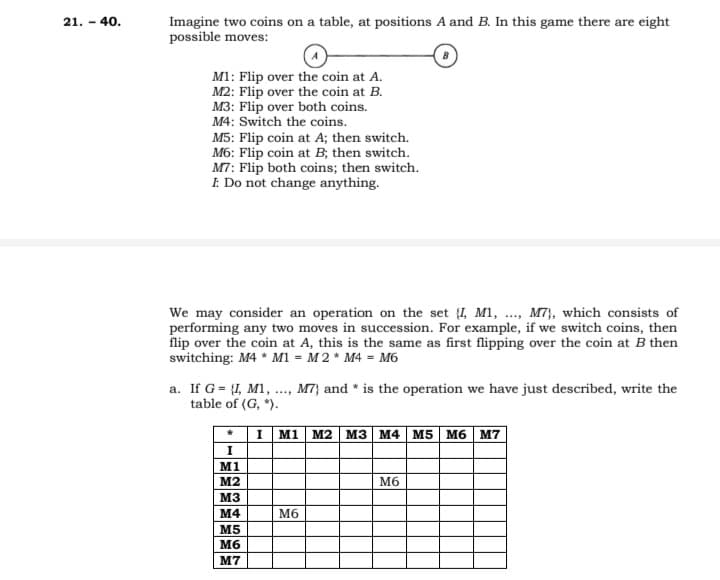21.-40. Imagine two coins on a table, at positions A and B. In this game there are eight possible moves: M1: Flip over the coin at A. M2: Flip over the coin at B. M3: Flip over both coins. M4: Switch the coins. M5: Flip coin at A; then switch. M6: Flip coin at B, then switch. M7: Flip both coins; then switch. E Do not change anything. We may consider an operation on the set I, M1, ..., M7), which consists of performing any two moves in succession. For example, if we switch coins, then flip over the coin at A, this is the same as first flipping over the coin at B then switching: M4* M1 = M2 M4 = M6 a. If G= {I, M1, ..., M7) and is the operation we have just described, write the table of (G, *). I M1 M2 M3 M4 M5 M6 M7 I M1 M2 M6 M3 M4 M6 M5 M6 M7
21.-40. Imagine two coins on a table, at positions A and B. In this game there are eight possible moves: M1: Flip over the coin at A. M2: Flip over the coin at B. M3: Flip over both coins. M4: Switch the coins. M5: Flip coin at A; then switch. M6: Flip coin at B, then switch. M7: Flip both coins; then switch. E Do not change anything. We may consider an operation on the set I, M1, ..., M7), which consists of performing any two moves in succession. For example, if we switch coins, then flip over the coin at A, this is the same as first flipping over the coin at B then switching: M4* M1 = M2 M4 = M6 a. If G= {I, M1, ..., M7) and is the operation we have just described, write the table of (G, *). I M1 M2 M3 M4 M5 M6 M7 I M1 M2 M6 M3 M4 M6 M5 M6 M7
Computer Networking: A Top-Down Approach (7th Edition)
7th Edition
ISBN:9780133594140
Author:James Kurose, Keith Ross
Publisher:James Kurose, Keith Ross
Chapter1: Computer Networks And The Internet
Section: Chapter Questions
Problem R1RQ: What is the difference between a host and an end system? List several different types of end...
Related questions
Question
100%
Please complete the Cayley's Table. Kindly include the complete solution. Thank you

Transcribed Image Text:21. - 40.
Imagine two coins on a table, at positions A and B. In this game there are eight
possible moves:
M1: Flip over the coin at A.
M2: Flip over the coin at B.
M3: Flip over both coins.
M4: Switch the coins.
M5: Flip coin at A; then switch.
M6: Flip coin at B; then switch.
M7: Flip both coins; then switch.
I: Do not change anything.
We may consider an operation on the set I, M1, ..., M7), which consists of
performing any two moves in succession. For example, if we switch coins, then
flip over the coin at A, this is the same as first flipping over the coin at B then
switching: M4 M1 M2 M4 M6
*
a. If G = (I, M1, ..., M7) and is the operation we have just described, write the
table of (G, *).
I M1 M2 M3 M4 M5 M6 M7
I
M1
M2
M6
M3
M4
M6
M5
M6
M7
Expert Solution
This question has been solved!
Explore an expertly crafted, step-by-step solution for a thorough understanding of key concepts.
This is a popular solution!
Trending now
This is a popular solution!
Step by step
Solved in 2 steps

Recommended textbooks for you

Computer Networking: A Top-Down Approach (7th Edi…
Computer Engineering
ISBN:
9780133594140
Author:
James Kurose, Keith Ross
Publisher:
PEARSON

Computer Organization and Design MIPS Edition, Fi…
Computer Engineering
ISBN:
9780124077263
Author:
David A. Patterson, John L. Hennessy
Publisher:
Elsevier Science

Network+ Guide to Networks (MindTap Course List)
Computer Engineering
ISBN:
9781337569330
Author:
Jill West, Tamara Dean, Jean Andrews
Publisher:
Cengage Learning

Computer Networking: A Top-Down Approach (7th Edi…
Computer Engineering
ISBN:
9780133594140
Author:
James Kurose, Keith Ross
Publisher:
PEARSON

Computer Organization and Design MIPS Edition, Fi…
Computer Engineering
ISBN:
9780124077263
Author:
David A. Patterson, John L. Hennessy
Publisher:
Elsevier Science

Network+ Guide to Networks (MindTap Course List)
Computer Engineering
ISBN:
9781337569330
Author:
Jill West, Tamara Dean, Jean Andrews
Publisher:
Cengage Learning

Concepts of Database Management
Computer Engineering
ISBN:
9781337093422
Author:
Joy L. Starks, Philip J. Pratt, Mary Z. Last
Publisher:
Cengage Learning

Prelude to Programming
Computer Engineering
ISBN:
9780133750423
Author:
VENIT, Stewart
Publisher:
Pearson Education

Sc Business Data Communications and Networking, T…
Computer Engineering
ISBN:
9781119368830
Author:
FITZGERALD
Publisher:
WILEY